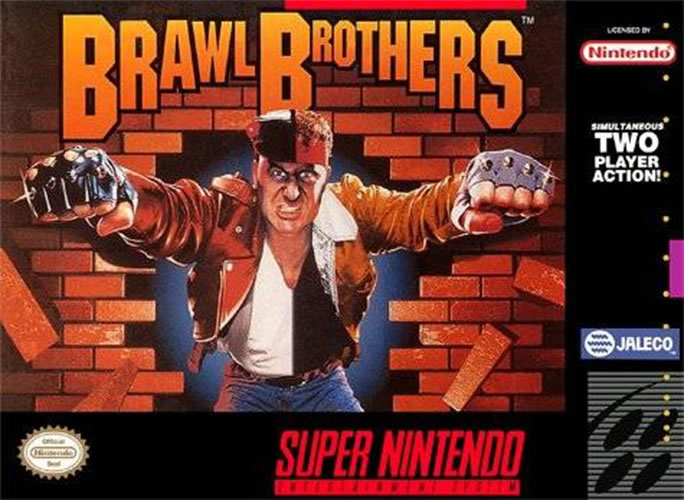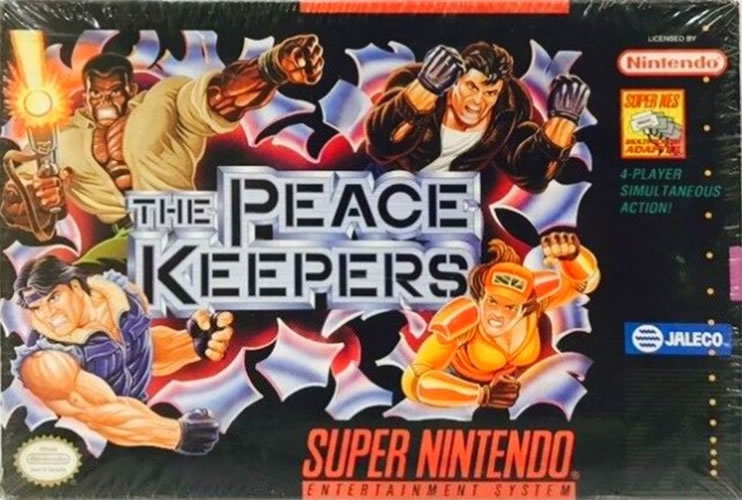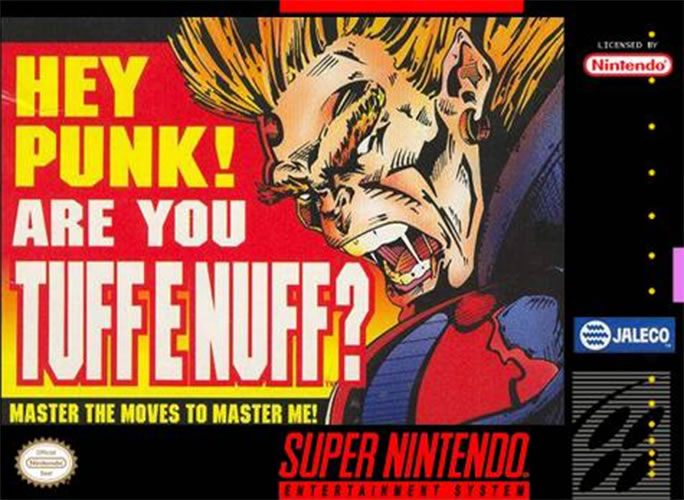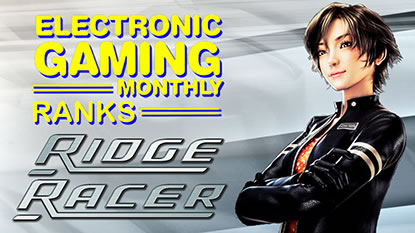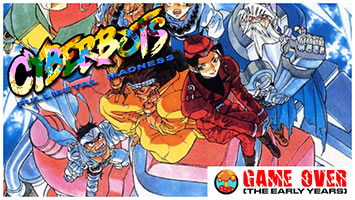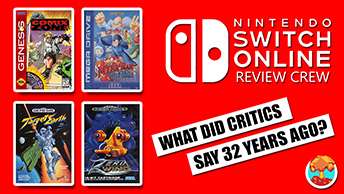- CLASSIC MAGAZINES
- REVIEW CREW
A show recapping what critics thought back
when classic games first came out! - NEXT GENERATION'S BEST & WORST
From the worst 1-star reviews to the best
5-stars can offer, this is Next Generation! - NINTENDO POWER (ARCHIVE)
Experience a variety of shows looking at the
often baffling history of Nintendo Power! - MAGAZINE RETROSPECTIVE
We're looking at the absolutely true history of
some of the most iconic game magazines ever! - SUPER PLAY'S TOP 600
The longest and most ambitious Super NES
countdown on the internet! - THEY SAID WHAT?
Debunking predictions and gossip found
in classic video game magazines! - NEXT GENERATION UNCOVERED
Cyril is back in this spin-off series, featuring the
cover critic review the art of Next Generation! - HARDCORE GAMER MAGAZING (PDF ISSUES)
Download all 36 issues of Hardcore Gamer
Magazine and relive the fun in PDF form!
- REVIEW CREW
- ELECTRONIC GAMING MONTHLY
- ELECTRONIC GAMING MONTHLY RANKS
From Mario to Sonic to Street Fighter, EGM
ranks classic game franchises and consoles! - ELECTRONIC GAMING MONTHLY BEST & WORST
Counting down EGM’s best and worst reviews
going year by year, from 1989 – 2009! - ELECTRONIC GAMING BEST & WORST AWARDS
11-part video series chronicling the ups and
downs of EGM’s Best & Worst Awards!
- ELECTRONIC GAMING MONTHLY RANKS
- GAME HISTORY
- GAME OVER: STORY BREAKDOWNS
Long-running series breaking down game
stories and analyzing their endings! - A BRIEF HISTORY OF GAMING w/ [NAME HERE]
Real history presented in a fun and pithy
format from a variety of game historians! - THE BLACK SHEEP
A series looking back at the black sheep
entries in popular game franchises! - INSTANT EXPERT
Everything you could possibly want to know
about a wide variety of gaming topics! - FREEZE FRAME
When something familiar happens in the games
industry, we're there to take a picture! - I'VE GOT YOUR NUMBER
Learn real video game history through a series
of number-themed episodes, starting at zero! - GREAT MOMENTS IN BAD ACTING
A joyous celebration of some of gaming's
absolute worst voice acting!
- GAME OVER: STORY BREAKDOWNS
- POPULAR SHOWS
- DG NEWS w/ LORNE RISELEY
Newsman Lorne Riseley hosts a regular
series looking at the hottest gaming news! - REVIEW REWIND
Cyril replays a game he reviewed 10+ years
ago to see if he got it right or wrong! - ON-RUNNING FEUDS
Defunct Games' longest-running show, with
editorials, observations and other fun oddities! - DEFUNCT GAMES QUIZ (ARCHIVE)
From online quizzes to game shows, we're
putting your video game knowledge to the test!- QUIZ: ONLINE PASS
Take a weekly quiz to see how well you know
the news and current gaming events! - QUIZ: KNOW THE GAME
One-on-one quiz show where contestants
find out if they actually know classic games! - QUIZ: THE LEADERBOARD
Can you guess the game based on the classic
review? Find out with The Leaderboard!
- QUIZ: ONLINE PASS
- DEFUNCT GAMES VS.
Cyril and the Defunct Games staff isn't afraid
to choose their favorite games and more! - CYRIL READS WORLDS OF POWER
Defunct Games recreates classic game
novelizations through the audio book format!
- DG NEWS w/ LORNE RISELEY
- COMEDY
- GAME EXPECTANCY
How long will your favorite hero live? We crunch
the numbers in this series about dying! - VIDEO GAME ADVICE
Famous game characters answer real personal
advice questions with a humorous slant! - FAKE GAMES: GUERILLA SCRAPBOOK
A long-running series about fake games and
the people who love them (covers included)! - WORST GAME EVER
A contest that attempts to create the worst
video game ever made, complete with covers! - LEVEL 1 STORIES
Literature based on the first stages of some
of your favorite classic video games! - THE COVER CRITIC
One of Defunct Games' earliest shows, Cover
Critic digs up some of the worst box art ever! - COMMERCIAL BREAK
Take a trip through some of the best and
worst video game advertisements of all time! - COMIC BOOK MODS
You've never seen comics like this before.
A curious mix of rewritten video game comics!
- GAME EXPECTANCY
- SERIES ARCHIVE
- NINTENDO SWITCH ONLINE ARCHIVE
A regularly-updated list of every Nintendo
Switch Online release, plus links to review! - PLAYSTATION PLUS CLASSIC ARCHIVE
A comprehensive list of every PlayStation
Plus classic release, including links! - RETRO-BIT PUBLISHING ARCHIVE
A regularly-updated list of every Retro-Bit
game released! - REVIEW MARATHONS w/ ADAM WALLACE
Join critic Adam Wallace as he takes us on a
classic review marathon with different themes!- DEFUNCT GAMES GOLF CLUB
Adam Wallace takes to the links to slice his way
through 72 classic golf game reviews! - 007 IN PIXELS
Adam Wallace takes on the world's greatest spy
as he reviews 15 weeks of James Bond games! - A SALUTE TO VAMPIRES
Adam Wallace is sinking his teeth into a series
covering Castlevania, BloodRayne and more! - CAPCOM'S CURSE
Adam Wallace is celebrating 13 days of Halloween
with a line-up of Capcom's scariest games! - THE FALL OF SUPERMAN
Adam Wallace is a man of steel for playing
some of the absolute worst Superman games! - THE 31 GAMES OF HALLOWEEN
Adam Wallace spends every day of October afraid
as he reviews some of the scariest games ever! - 12 WEEKS OF STAR TREK
Adam Wallace boldly goes where no critic has
gone before in this Star Trek marathon!
- DEFUNCT GAMES GOLF CLUB
- DAYS OF CHRISTMAS (ARCHIVE)
Annual holiday series with themed-episodes
that date all the way back to 2001!- 2015: 30 Ridiculous Retro Rumors
- 2014: 29 Magazines of Christmas
- 2013: 29 Questionable Power-Ups of Christmas
- 2012: 34 Theme Songs of Christmas
- 2011: 32 Game Endings of Christmas
- 2010: 31 Bonus Levels of Christmas
- 2009: 30 Genres of Christmas
- 2008: 29 Controls of Christmas
- 2007: 34 Cliches of Christmas
- 2006: 33 Consoles of Christmas
- 2005: 32 Articles of Christmas
- 2004: 31 Websites of Christmas
- 2003: 29 Issues of Christmas
- 2002: 28 Years of Christmas
- 2001: 33 Days of Christmas
- NINTENDO SWITCH ONLINE ARCHIVE
- REVIEW ARCHIVE
- FULL ARCHIVE
Nintendo Switch Online: 1990s Critics Review Tuff E Nuff, Brawl Brothers & Peace Keepers
This week, Nintendo announced that Kirby and the Amazing Mirror will be heading to the Nintendo Switch Online Expansion Pack on September 29th. We're going to dedicate a full episode to not only covering that release, but all of the Kirby games we've missed in the run of this series. That's happening next Friday, but first we're going hit three Jaleco beat ‘em ups that have yet to be covered in the Review Crew, including The Peace Keepers, Tuff E Nuff and Brawl Brothers. Those games may have hit Nintendo's service years ago, but the question remains: Are any of them worth playing? To answer that question, I decided to flip through the pages of Electronic Gaming Monthly, GamePro, Die Hard Game Fan and more classic magazines to see what the critics said back when these games first came out. So, get ready to punch a mutant and eat directly out of a garbage can, because it's time for another eye-gouging episode of Nintendo Switch Online Review Crew.
Although it's hard to tell based on the name and the box, Brawl Brothers is the sequel to a game we've previously covered – the so-so beat ‘em up Rival Turf. The dark middle chapter of the Rushing Beat trilogy, this brawler came out in 1993 and tried its hardest to ride on the success of games like Final Fight and Streets of Rage. The graphics are better, the gameplay is tighter and the Super NES cartridge even featured the full Japanese version (through a cheat code). Unfortunately, this was a time of transition, and while gamers may have been into beat ‘em ups a year or two earlier, their interest had moved almost entirely to one-on-one fighting games inspired by Street Fighter II. Here in America, Brawl Brothers barely made a splash.
You see that in the lack of reviews, with most magazines of the era choosing not to cover yet another beat ‘em up. Giving it a 2.9 out of 5, I suspect that Nintendo Power spoke for a lot of critics at the time when they complained that there was “nothing new in the street fighting genre” and was frustrated by the “small variety of moves.” That said, they did commend the “good graphics and cool characters,” as well as the two-player action, so it wasn't all bad.
And the truth is, we did see other magazines who were not quite ready to give up on the beat ‘em up genre. For example, Nintendo Magazine System gave Brawl Brothers an 84%, which is significantly better than the 48% they gave Rival Turf. The same is not true for GamePro, who gave both Rival Turf and this sequel scores of 4 out of 5. “While Brawl Brothers is an obvious Final Fight knock-off, it's a good one. If it had a greater variety of enemies, it might well have taken out the current 16-bit beat ‘em up champ, Streets of Rage 2. Video vigilantes who've polished off other games should bring Brawl Brothers into their family.”
When it comes down to it, I agree with both Nintendo Power and GamePro. It's true that Brawl Brothers doesn't bring a lot of new ideas to the genre, but the action is still exciting and the graphics look great. Give it a play; it's not very long.
One year after the release of Brawl Brothers, we were treated to the epic conclusion to the trilogy – The Peace Keepers. This sequel gives us more characters, more moves, more bad guys and, best of all, more wide-open locations to use those moves and beat up those bad guys. This is, in most regards, a better beat ‘em up that at least tried to evolve the genre, what with brand-new super moves, branching paths and even multiple endings. But did that move the needle for the critics who had largely written off the brawler genre by 1994? Not even a little bit.
Electronic Gaming Monthly, for example, sidelined The Peace Keepers with nothing more than a capsule review with scores ranging from Al's 4 all the way up to an 8 from Mike. “This is a very long and very good fighting game like Brawl Brothers. Huge levels and non-linear gameplay make this one quite a trip. The four-on-four free-for-all is a nice option, but doesn't come off that well. A good action/fighter.” EGM gave the game an average score of 6.4 out of 10.
When it comes to Nintendo Power, the good news is that they liked The Peace Keepers more than Brawl Brothers. Of course, the bad news is that it wasn't by much, going from a 2.9 out of 5 to a 3. Barely an improvement. Similarly, GamePro stuck with the same score they gave both Rival Turf and Brawl Brothers – a straight 4 out of 5. They concluded that “The Peace Keepers is a slick piece of work. With good fighting action, sharp graphics and even Shakespearean dialogue, this cart's a keeper. This courageous cart keeps the peace with bust-your-thumbs beat ‘em up action and unusual, eye-catching visuals.”
Once again, I find myself siding with GamePro. That said, if you're going to play this game, try and seek out the Japanese version. The American localization is all over the place, going as far as to change the music and even simplify the animation. That's disappointing, but you can still have a whole bunch of fun with the version of the Nintendo Switch Online. Give it a try.
Hey, remember how I just complained about Jaleco's crummy localizations? A great example of that is their 1993 fighting game Dead Dance, which was released in the United States under the laughably bad Tuff E Nuff name. That's right, it's literally a title where not a single word is spelled correctly, because apparently Americans are illiterate. Look, maybe this annoys me more than others because of my writing and copy-editing background, but it took me a while to appreciate what Jaleco was doing with this futuristic fighting game. Between the story mode and the gameplay, it's clear that the developers were heavily influenced by both SNK's Art of Fighting and, of course, Street Fighter II from Capcom. It was also released in 1993, early enough in the fighting game craze where people weren't completely burned out of fireballs and dragon punches. But what did the critics say? Did they like this more than Jaleco's side-scrolling beat ‘em ups?
The first thing you'll notice is that pretty much every publication reviewed Tuff E Nuff, mostly because it was a fighting game released in 1993. That alone was going to get you a lot of attention, as well as more than a few direct comparisons. That was certainly the case when it came to Electronic Gaming Monthly, who mostly liked the game, giving it a 7.5 out of 10. Steve said that “Jaleco is getting better and better all the time! Following the surprise hit Brawl Brothers, here is another fighting game more in the vein of Street Fighter 2. The different options (such as fighting a wide variety of opponents or one-on-one against a friend) are welcome. A must-have for fighting fans of all ages.” Ed also liked it, but gave it a slightly lower score: “With the slew of fighting games now coming out, Tuff E Nuff ranks pretty high in my book. The moves are nothing really spectacular, but the feel of the game is good. It's another good fighting game that must join the growing ranks of this genre.”
EGM's score nearly mirrors that of Video Games & Computer Entertainment, which gave Tuff E Nuff a solid 7.2 out of 10. Nintendo Power, on the other hand, went way lower, giving it a 3.1 out of 5, which is right in line with the other two Jaleco titles we've covered in this episode. And then there's SNES Force, who gave it an average score of 65% and called it a “bad Street Fighter II clone.” Simon argued that the “gameplay is virtually the same, the layout is also similar. However, Jaleco have used only four of the SNES's six buttons, so the number of moves is not equal to SFII. The final nail in Tuff E Nuff's coffin is the difficulty setting. I completed the normal level on my first attempt, and nearly completed the hard setting in a day. Not the challenge you expect for this price. Wait for Street Fighter II Turbo.”
The highest scores I could find came from Die Hard Game Fan, who disagreed with SNES Force and gave Tuff E Nuff an average score of 90%. The Enquirer loved the game, raving that “Jaleco's first Super NES fighting game is truly amazing. The control is what makes the game so good. It's perfect. The graphics are good, but what really makes the game shine are the characters and how easy it is to perform combos. A 16 meg fighting game that needs to be brought to the arcades.” Game Fan's lowest score came from Sgt. Gamer, who concluded that “the moves, animation and beautiful backgrounds add up to a super surprise from Jaleco. For a company that made its rep with baseball games, they're incredibly adept at making quality fighters.”
Now, if you're wondering what GamePro thought, then you probably won't be too surprised when I tell you that they gave Tuff E Nuff a score of 4 out of 5. Hey, at least they are consistent. “This game is a fun fighter – sort of a Junior Street Fighter II. You may burn some new blisters with the awesome combos, but with only four characters to choose from, this light fighter is too easy for most street fightin' vets. The sleek action, smooth sprite movement and detailed backgrounds of this cart may just not be Enuff.”
The truths is, Tuff E Nuff is a Street Fighter II clone that, while fun, is a little hard to go back to. There are a lot of little problems that keep this from matching the greats of the franchise, but it's still worth checking out on the Switch. Give it a play, especially if you have friends around.
| Publication | Scores |
|---|---|
| Nintendo Magazine System | 84% |
| GamePro | 4/5 |
| Nintendo Power | 2.9/5 |
| AVERAGE SCORE | 56% |
You see that in the lack of reviews, with most magazines of the era choosing not to cover yet another beat ‘em up. Giving it a 2.9 out of 5, I suspect that Nintendo Power spoke for a lot of critics at the time when they complained that there was “nothing new in the street fighting genre” and was frustrated by the “small variety of moves.” That said, they did commend the “good graphics and cool characters,” as well as the two-player action, so it wasn't all bad.
And the truth is, we did see other magazines who were not quite ready to give up on the beat ‘em up genre. For example, Nintendo Magazine System gave Brawl Brothers an 84%, which is significantly better than the 48% they gave Rival Turf. The same is not true for GamePro, who gave both Rival Turf and this sequel scores of 4 out of 5. “While Brawl Brothers is an obvious Final Fight knock-off, it's a good one. If it had a greater variety of enemies, it might well have taken out the current 16-bit beat ‘em up champ, Streets of Rage 2. Video vigilantes who've polished off other games should bring Brawl Brothers into their family.”
When it comes down to it, I agree with both Nintendo Power and GamePro. It's true that Brawl Brothers doesn't bring a lot of new ideas to the genre, but the action is still exciting and the graphics look great. Give it a play; it's not very long.
| Publication | Scores |
|---|---|
| GamePro | 4/5 |
| Electronic Gaming Monthly | 6.4/10 |
| Nintendo Power | 3/5 |
| AVERAGE SCORE | 68% |
Electronic Gaming Monthly, for example, sidelined The Peace Keepers with nothing more than a capsule review with scores ranging from Al's 4 all the way up to an 8 from Mike. “This is a very long and very good fighting game like Brawl Brothers. Huge levels and non-linear gameplay make this one quite a trip. The four-on-four free-for-all is a nice option, but doesn't come off that well. A good action/fighter.” EGM gave the game an average score of 6.4 out of 10.
When it comes to Nintendo Power, the good news is that they liked The Peace Keepers more than Brawl Brothers. Of course, the bad news is that it wasn't by much, going from a 2.9 out of 5 to a 3. Barely an improvement. Similarly, GamePro stuck with the same score they gave both Rival Turf and Brawl Brothers – a straight 4 out of 5. They concluded that “The Peace Keepers is a slick piece of work. With good fighting action, sharp graphics and even Shakespearean dialogue, this cart's a keeper. This courageous cart keeps the peace with bust-your-thumbs beat ‘em up action and unusual, eye-catching visuals.”
Once again, I find myself siding with GamePro. That said, if you're going to play this game, try and seek out the Japanese version. The American localization is all over the place, going as far as to change the music and even simplify the animation. That's disappointing, but you can still have a whole bunch of fun with the version of the Nintendo Switch Online. Give it a try.
| Publication | Scores |
|---|---|
| Die Hard Game Fan | 90% |
| Nintendo Magazine System | 89% |
| GamePro | 4/5 |
| Electronic Gaming Monthly | 7.5/10 |
| Video Games & Computer Entertainment | 7.2/10 |
| SNES Force | 65% |
| Nintendo Power | 3.1/5 |
| AVERAGE SCORE | 76% |
The first thing you'll notice is that pretty much every publication reviewed Tuff E Nuff, mostly because it was a fighting game released in 1993. That alone was going to get you a lot of attention, as well as more than a few direct comparisons. That was certainly the case when it came to Electronic Gaming Monthly, who mostly liked the game, giving it a 7.5 out of 10. Steve said that “Jaleco is getting better and better all the time! Following the surprise hit Brawl Brothers, here is another fighting game more in the vein of Street Fighter 2. The different options (such as fighting a wide variety of opponents or one-on-one against a friend) are welcome. A must-have for fighting fans of all ages.” Ed also liked it, but gave it a slightly lower score: “With the slew of fighting games now coming out, Tuff E Nuff ranks pretty high in my book. The moves are nothing really spectacular, but the feel of the game is good. It's another good fighting game that must join the growing ranks of this genre.”
EGM's score nearly mirrors that of Video Games & Computer Entertainment, which gave Tuff E Nuff a solid 7.2 out of 10. Nintendo Power, on the other hand, went way lower, giving it a 3.1 out of 5, which is right in line with the other two Jaleco titles we've covered in this episode. And then there's SNES Force, who gave it an average score of 65% and called it a “bad Street Fighter II clone.” Simon argued that the “gameplay is virtually the same, the layout is also similar. However, Jaleco have used only four of the SNES's six buttons, so the number of moves is not equal to SFII. The final nail in Tuff E Nuff's coffin is the difficulty setting. I completed the normal level on my first attempt, and nearly completed the hard setting in a day. Not the challenge you expect for this price. Wait for Street Fighter II Turbo.”
The highest scores I could find came from Die Hard Game Fan, who disagreed with SNES Force and gave Tuff E Nuff an average score of 90%. The Enquirer loved the game, raving that “Jaleco's first Super NES fighting game is truly amazing. The control is what makes the game so good. It's perfect. The graphics are good, but what really makes the game shine are the characters and how easy it is to perform combos. A 16 meg fighting game that needs to be brought to the arcades.” Game Fan's lowest score came from Sgt. Gamer, who concluded that “the moves, animation and beautiful backgrounds add up to a super surprise from Jaleco. For a company that made its rep with baseball games, they're incredibly adept at making quality fighters.”
Now, if you're wondering what GamePro thought, then you probably won't be too surprised when I tell you that they gave Tuff E Nuff a score of 4 out of 5. Hey, at least they are consistent. “This game is a fun fighter – sort of a Junior Street Fighter II. You may burn some new blisters with the awesome combos, but with only four characters to choose from, this light fighter is too easy for most street fightin' vets. The sleek action, smooth sprite movement and detailed backgrounds of this cart may just not be Enuff.”
The truths is, Tuff E Nuff is a Street Fighter II clone that, while fun, is a little hard to go back to. There are a lot of little problems that keep this from matching the greats of the franchise, but it's still worth checking out on the Switch. Give it a play, especially if you have friends around.
HOME |
CONTACT |
NOW HIRING |
WHAT IS DEFUNCT GAMES? |
NINTENDO SWITCH ONLINE |
RETRO-BIT PUBLISHING
Retro-Bit |
Switch Planet |
The Halcyon Show |
Same Name, Different Game |
Dragnix |
Press the Buttons
Game Zone Online | Hardcore Gamer | The Dreamcast Junkyard | Video Game Blogger
Dr Strife | Games For Lunch | Mondo Cool Cast | Boxed Pixels | Sega CD Universe | Gaming Trend
Game Zone Online | Hardcore Gamer | The Dreamcast Junkyard | Video Game Blogger
Dr Strife | Games For Lunch | Mondo Cool Cast | Boxed Pixels | Sega CD Universe | Gaming Trend
Copyright © 2001-2025 Defunct Games
All rights reserved. All trademarks are properties of their respective owners.
All rights reserved. All trademarks are properties of their respective owners.







